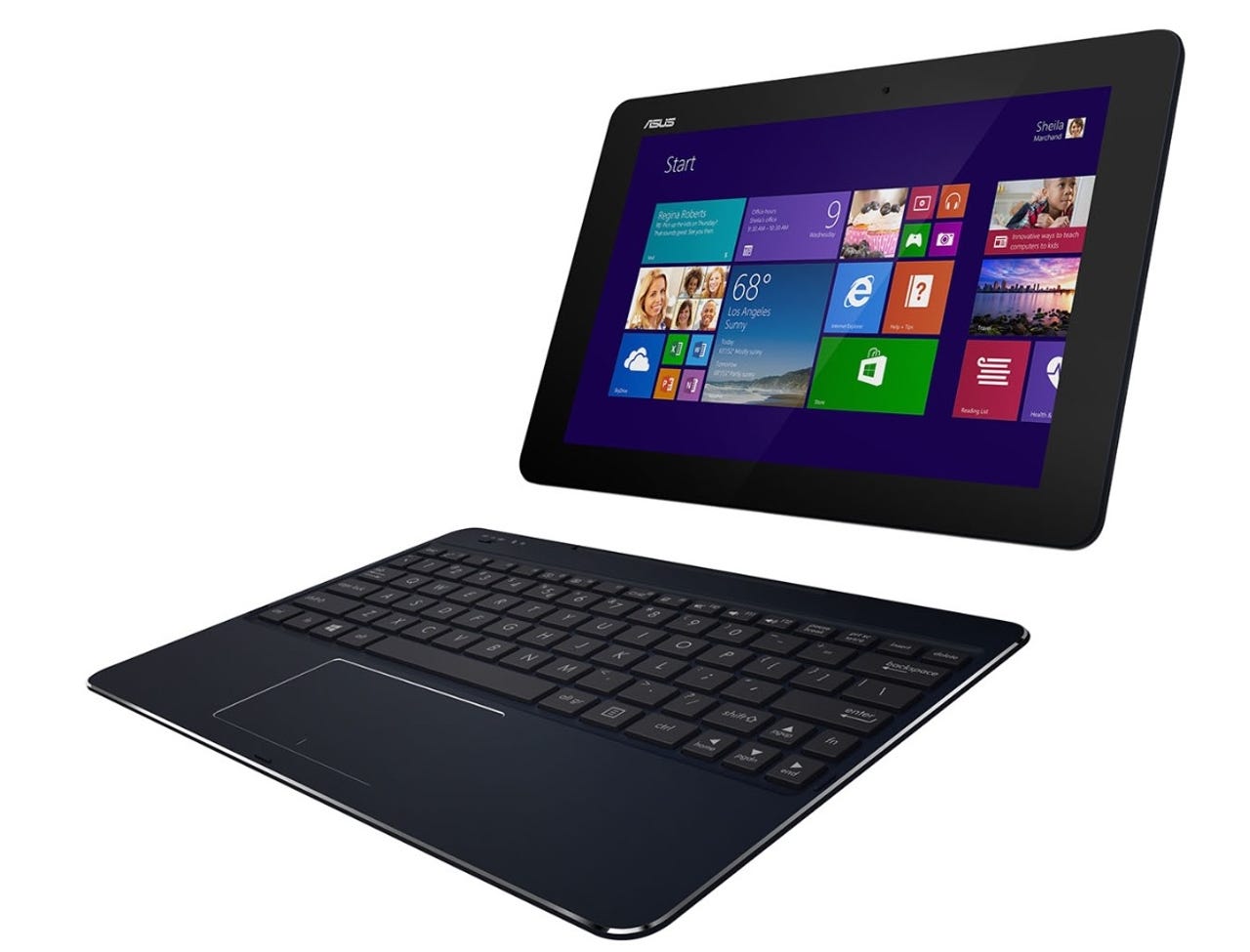Hands on the Asus Transformer Book T100 Chi


The T100 Chi has a lot in common with the old T100TA: both machines are 10.1-inch tablets supplied in laptop format with a keyboard dock. However, the Chi version looks and feels much nicer: it's much more solid, and seems to be metal rather than plastic. It has a 10 touch-point IPS screen with a Full HD resolution of 1900 x 1080 pixels. Surprisingly, for a laptop at this price level, it also comes with a Synaptics digitizing pen (similar to Dell).
The T100 Chi is very thin and light. It measures 265 x 174.5 x 13.5mm and it weighs only 1.08kg - 0.57kg for the tablet and 0.51kg for the keyboard dock. Without the dock, Asus claims the T100 Chi is "the world's thinnest Windows tablet at an incredible 7.2mm".
For comparison, the 11-inch MacBook Air measures 300 x 192 x 17mm, and also weighs 1.08kg, but it only has a screen resolution of 1366 x 768 pixels. If you think the MacBook Air is small, the T100 Chi is noticeably smaller. (Yes, it's also much less powerful.)
Docking keyboard
The T100 Chi has a completely different docking system from the old T100TA. It's simpler and quicker because you just have to slot the screen onto a couple of small tabs, then it is held in place by strong magnets. It solves the problem from which the T100TA and Asus's pioneering Android-based Transformers suffered: a tendency to tip over. The screen doesn't tilt all the way back, but at the maximum allowed, it's very stable.
I assume that the T100 Chi dock could have the same problems as other Bluetooth keyboards, and will sometimes go to sleep or become unpaired. Neither happened to me, but I only got the machine on Friday afternoon.... In addition, charging the tablet/laptop doesn't charge the keyboard, so you have to remember to do that separately every once in a while.
The keyboard is slightly better than the one in the T100TA, and doesn't flex as much. The basic layout, cursor keys and oversized Enter key are all good. The one that will catch a few people out is the backslash key between the z and the left shift key.
Of course, the 10.1-inch screen means the keyboard is reduced in size, and the keys are not very responsive. It's not very good for touch-typing, but it's much better than the keyboards generally used in cheap tablet cases. Either way, T100 Chi owners will get used to it.
The Bluetooth keyboard dock also provides a bonus feature: it still works even if the screen is some distance from the keyboard. This may have ergonomic advantages if you have some way of fixing the screen in a higher position.
Tech specs
The T1000 Chi's specifications are standard for today's 2-in-1 hybrid laptops in the £200 to £300 ($200-$300) category, so I presume they're imposed by Intel. It has a 1.46 GHz ~ 2.39 GHz quad-core Intel Atom Z3775 processor, 2GB of memory, and 64GB of eMMC storage. Connectivity includes micro-USB 3.0 and 2.0 ports, a micro-HDMI video port, and a headphone jack. There's also a microSD card slot, so you can expand the storage.
The Z3775 is a snappy performer and slightly faster than other Bay Trail designs such as Celeron N2940 and even some second-gen Core i3 chips, In fact, it's almost as fast as a Core i3-4020Y. However, the eMMC drive is much slower than an SSD, and 2GB of memory is going to limit the T100 Chi's usefulness. It's fine for applications such as Microsoft Word, but it's less than ideal for bloatware such as Apple iTunes or Google Chrome and Google Docs.
The Z3775 can support 4GB, and if Asus offered it, I'd happily pay the extra: it can't make that much difference. I'd also have preferred the 64-bit version of Windows, even though it takes up more room on the Flash drive.
What is it for?
The T100 Chi is much like a netbook, except for being thinner, much faster, and having a far superior screen (1920 x 1080 pixels vs the old 1024 x 600). It's a great ultraportable, a decent laptop for casual use, and - if you detach the keyboard - a useful multi-tasking, multi-user 10-inch tablet. But it's obviously not a workstation, and it's not suitable for video editing or playing serious games.
However, it can run Microsoft Office so, up to a point, it can do serious work. The light weight, relatively solid build quality, Full HD screen and good battery life would make it a suitable candidate for travelling executives. All those features plus the ability to double as a laptop and a tablet would also make it attractive in the education market, where the small keyboard is less of a drawback.
As usual, it depends what you want.
When I took the T100 Chi home for the weekend, I bitched like a geek about Asus's failure to equip it with 4GB of memory, a fully-connected keyboard and so on - features that appear in the somewhat larger and more expensive Asus T300 Chi. My wife, who runs a shop, saw it differently. She liked the build quality, the small size and light weight - she wants something that fits in a handbag - and the improved screen resolution. And since she rarely opens more than two or three programs and four or five browser tabs, the T100 Chi had performance to spare. Her only real complaint was that the choice of colours doesn't stretch beyond black.
I may have trouble getting it back....